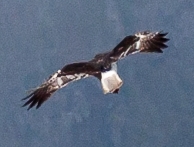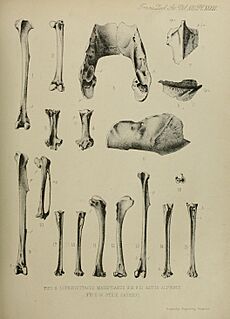Réunion harrier facts for kids
Quick facts for kids Réunion harrier |
|
|---|---|
 |
|
| Male in flight | |
| Conservation status | |
| Scientific classification | |
| Genus: |
Circus
|
| Species: |
maillardi
|
 |
|
The Réunion harrier (Circus maillardi) is a special type of bird of prey. It's also known as the Réunion marsh harrier. People on the island of Réunion call it the papangue or pied jaune.
This bird is only found on the island of Réunion in the Indian Ocean. Scientists have also found old bones of this bird on the nearby island of Mauritius. The Réunion harrier is an endangered species, meaning its numbers are getting very low.
Contents
About the Réunion Harrier
What Does It Look Like?
The Réunion harrier is about 42 to 55 centimeters (16 to 22 inches) long. Female birds are a bit bigger than males.
Male harriers have a blackish head and back with white stripes. Their belly, underwings, and rump (the area above the tail) are white. Their tail is grey. Their wings are grey and black with a white front edge.
Female and young harriers are dark brown. They have a white rump and a tail with stripes.
What Sounds Does It Make?
These birds are usually quiet. But during the time they are raising their young, they make different sounds. They might make a chattering sound if they feel threatened. They also have a wailing call for courtship and chuckling sounds when they find food.
Where It Lives and What It Eats
Its Home
The Réunion harrier usually lives in forested mountain areas. These areas are typically between 300 and 700 meters (about 1,000 to 2,300 feet) above sea level. They also visit sugarcane fields and grassy areas.
What's on the Menu?
Today, these harriers eat many animals that were brought to the island by people. This includes rats, mice, and tenrecs (small, spiny mammals). Long ago, they mostly ate other birds and insects. They also hunt small lizards, frogs, and will sometimes eat dead animals.
Special Hunting Skills
The Réunion harrier has some unique features for hunting. It has broad, rounded wings. These wings help it fly and hunt easily between trees. It also has short lower leg bones (called a tarsus) and long claws. These features are common in birds of prey that mostly hunt other birds.
Raising Young
Réunion harriers lay their eggs between January and May. They usually lay two or three white eggs. Their nest is built on the ground.
Why It Needs Our Help
How Many Are Left?
In 2011, experts thought there were at least 564 Réunion harriers. About 150 of these were breeding pairs. Because their numbers are low, BirdLife International has listed them as an endangered species.
What Threats Does It Face?
The Réunion harrier faces several dangers:
- Habitat Loss: Their homes are being destroyed or disturbed.
- Poaching: Some people illegally hunt these birds.
- Poisoning: They can accidentally get poisoned by chemicals used to kill rats and mice.
How We Protect It
The Réunion harrier became a protected species in 1966. Its numbers seemed to be stable or even growing until about 2000-2010. After that, their population started to decrease.
To help protect them, some special areas have been identified. These are called Important Bird Areas (IBAs). They include:
- Mouth of the Cirque de Salazie
- Ravine de la Grande Chaloupe
- Rivière des Marsouins – Grand Étang
- Rivière des Remparts - Rivière Langevin
Its Name and History
How It Got Its Name
The Réunion harrier was first described in 1862 by a scientist named Jules Verreaux. He named the bird after Louis Maillard. Louis Maillard was a French botanist and engineer who wrote about the bird in a book about Réunion island.
Its Relatives
The Malagasy harrier (C. macrosceles) lives on Madagascar and the Comoro Islands. For a long time, scientists thought it was the same species as the Réunion harrier. But now, many scientists believe they are separate species. DNA studies show they are very closely related but have been evolving separately for a long time. The Réunion harrier developed special features to hunt birds and bats in its forest home.
Scientists also found old bones of a hawk on Mauritius. At first, they thought it was a different bird. But later, they realized these bones were from the Réunion harrier. This means the Réunion harrier used to live on Mauritius too, but it is no longer found there.




